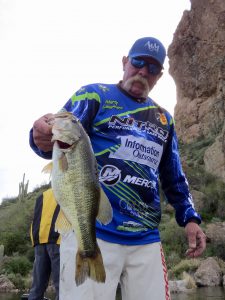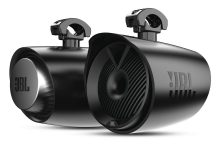AZ Lakes, AZ Pros: Marty Lawrence
Here Are His Prespawn Tips (For Any Lake)

Prespawn can be a difficult time for bass fishermen. Marty Lawrence’s advice on prespawn fishing is “don’t overthink it”. That being said, the man probably has 14 rods on the deck by the end of the day, and several of them will have a Senko tied on. He’ll throw the Senko Texas-rigged, wacky rigged with no weight, or wacky rigged with a nail weight for deeper cover. As for the Texas rigs, he’ll have one with weight pegged or with a bobber stopper, and one unpegged. The Texas rigs are for around trees and other vertical structure, and the wacky rigs are for dropping to submerged cover.
Crankbait, Jerkbait
Marty will also try a crankbait or jerkbait sometime during the day at varying depths, and he’s also a big fan of a Chatterbait with a Zako trailer. When he starts out in the morning he’ll have three or four different baits in different sizes and colors on the deck. He says when the water temperature gets close to 60 degrees, it’s time – pre-spawn really starts kicking into gear and it’s time to cover water, making sure to probe any rocks and trees you find in a cut.
Hula Grub
When the water is cold and the fishing is tough, a heavy football head jig with a Hula Grub is a killer combination. A heavy jig falls fast and kicks up mud and debris like a crawdad, so big bass really pound a one-tonner. The first time I ever caught a bass on one, I brought it all the way to the boat and it wasn’t hooked. It was just hanging on to that delicious Hula Grub, and when it saw me it turned and left. Didn’t even have the decency to look scared!
Big Football Jig
When fishing a big football jig, one of the best ways is to cast it out, hold the rod down, and watch the line. Most of the time if they take it on the fall the fish will grab it and turn, so you’ll see the line move sideways, but sometimes they’ll suck it in and keep coming at you, so you won’t get anything but a little tick of the line.If the line stays taut as the jig falls, just let line feed out until it goes slack – you can see that the jig has hit the bottom. If you cast out and turn the handle right away, the jig isn’t going to fall when you cast it – it will pendulum quite a bit closer to you and may not hit bottom at all.
Yamamoto Hula Grub
When you’re fishing a Yamamoto Hula Grub, it’s hard to beat Yamamoto Football Head jigs because the two rings are a lot easier on the soft baits than those barbs you find on most other jigs. You also need a good long jig rod with plenty of backbone and a fast reel. The reel needs to be fast because once a fish takes your jig, you have to be able to take the slack out of the line and hit him hard. If he’s headed right for you, that means some fast cranking. Good stout line without a lot of stretch is also ideal for the same reason. Those big hooks require power to penetrate a big fish.
Starts Out Fast
Marty says he usually starts out fast, bouncing the jig down the bank in spots he’s known from previous catches, running from spot to spot until he’s tried them all. Then he starts all over and this time he fishes the jig a little more slowly. In each spot, cast the jig at least three or four times. If you come to a likely looking tree or rock pile, work the jig through the tree or rocks. When you are dragging a jig over something, keep the line taut and feel the jig. When it starts to fall, push the rod forward to give it some slack so it falls down next to the cover instead of out away from it. Sometimes it’s like deep-water flipping. If you hang up, just get over the jig and pop it loose. It’s a lot faster than re-tying. However, if you’re fishing heavy cover, be sure to check the line often. Better to take the time to re-tie than break off a big fish.
Keep Trying
Marty said that a mistake some people make is to have good fish going during pre-fish in maybe five spots. They’ll hit the first one on tournament day, catch a couple of fish, then hit the other spots and not catch anything. So they’ll switch tactics and never go back. He says you need to have confidence in your bite. Fish aren’t active all the time, so you need to keep trying. Sometime during the day those fish will turn on and you’ll catch them.
A Great Trick
You can use a 1-oz jig as a search bait because you can fish it fast. Put the trolling motor on high, pitch it out, shake it a couple of times, then throw it again. A jig bite feels like the weight of the jig went away a lot of times. You feel, then you don’t. That’s when to set the hook. Violently. You can also crawl a big jig by lifting it up a bit, then letting it back down. When you get it back to the boat, try moving the boat just a little with the trolling motor. The jig will actually go backwards a little, just like a crawdad. A great trick for when it’s really tough.































